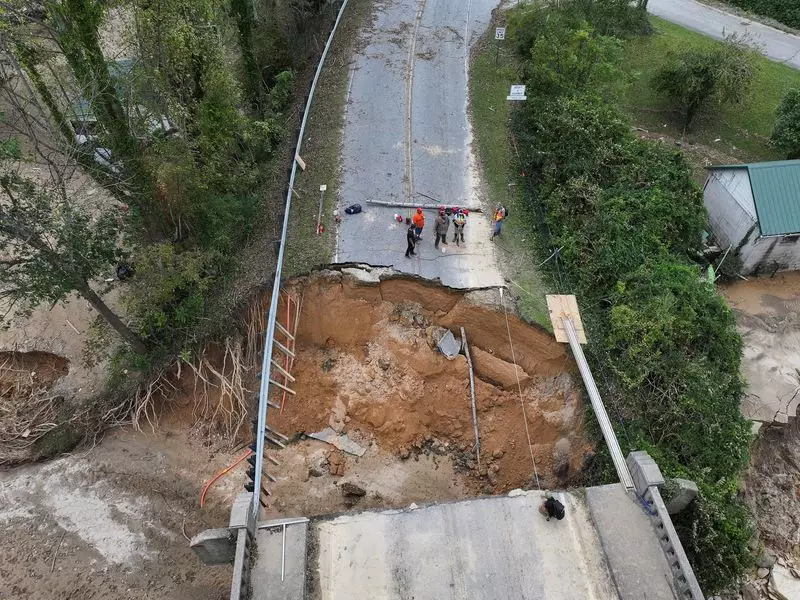The delicate beauty of Western North Carolina has been marred by the recent catastrophic impact of tropical storm Helene. What began as a hurricane that wreaked havoc on the Gulf coast of Florida quickly spiraled into a disaster of epic proportions for the Southeastern United States. With reports indicating fatalities exceeding 100 across several states, including North Carolina, South Carolina, Georgia, Florida, Tennessee, and Virginia, the storm has not only taken lives but also devastated communities, reducing neighborhoods to rubble and severing vital communication lines.
In towns like Bat Cave, North Carolina—just a short distance from the bustling city of Charlotte—the devastation is heart-wrenching. The storm’s unprecedented intensity transformed the landscape into what many describe as ‘post-apocalyptic.’ The Broad River, once a tranquil setting for locals, gushed to incomprehensible heights, dismantling homes and infrastructure in a matter of hours. Streets became untraceable waterways, while residents found themselves reliant on aerial missions to deliver emergency supplies.
As emergency responders mobilized to provide aid, countless families were left grappling with the question of survival. One family, led by Aaron Smith, found themselves with only a single suitcase following the storm’s onslaught. Their home, a once-stable refuge, fell victim to the rising waters of Hickory Creek. In a moment, their lives were forever changed—echoing a sentiment shared by many. Smith’s haunting words, “I don’t see anything to go back to,” signify a disturbing reality faced by countless residents who now find themselves displaced.
The precarious situation was further complicated by risks associated with collapsing infrastructure, as evidenced by the urgency with which locals intervened when private helicopters sought to land for evacuations. The inherent danger of the bridge—an essential connection to emergency services—was mocked by a “DON’T LAND” slogan spray-painted by firefighters, highlighting the chaos and uncertainty that permeated their day-to-day lives.
In response to the escalating crisis, local, state, and federal officials initiated a large-scale recovery effort, with FEMA stepping forward to assist the thousands of families who have registered for aid. More than 1.8 million residences were left without power, contributing to the pervasive sense of vulnerability among survivors. Governor Roy Cooper has taken the initiative to ensure that substantial resources will be allocated to both immediate and longer-term recovery efforts, promising that the state will not abandon its communities in the midst of such tribulation.
President Joe Biden has expressed intentions to visit the ravaged areas, attributing the intensity of the storm, in part, to climate change. His focus not only underscores the severity of the disaster but elevates the conversation surrounding climate resilience and sustainable infrastructure as foundation elements in recovering from future catastrophes.
The shared plight of those caught in Helene’s fierce grip extends beyond state borders. The national death toll, reported at 128, is a grim reminder of the wreckage left behind. Georgia and South Carolina have also reported significant loss of life, showing that Helene’s reach was indeed extensive, touching hearts across the entire Southeast.
Yet, amid the ruins lies a glimmer of resilience. Communities affected by tropical storm Helene are banding together, drawing strength from one another as they begin to navigate the recovery process. With assistance from the National Guard airlifting crucial supplies like food and water, the message of solidarity and support resonates far beyond state lines. Local responders, volunteers, and everyday citizens have stepped up, showcasing the undeniable spirit of collaboration that often rises from the ashes of devastation.
Charlotte City Councilman Tariq Bokhari captured the sentiments of many when he described the scene as “overwhelming” and lamented the impending challenges of recovery. Still, it is this same overwhelming sense of community that will ultimately play a pivotal role in rebuilding.
In the wake of such profound grief and destruction, the road ahead will be long and fraught with challenges. Communities will need time, effort, and funds to mend the physical and emotional wounds inflicted by Helene. Yet, if history has taught us anything, it is that the human spirit has an extraordinary capacity to adapt and persevere in even the darkest of times. As the skies clear and the rescue missions ramp up, the true story becomes one of hope—hope that with time, resilience can transform tragedy into renewal.

